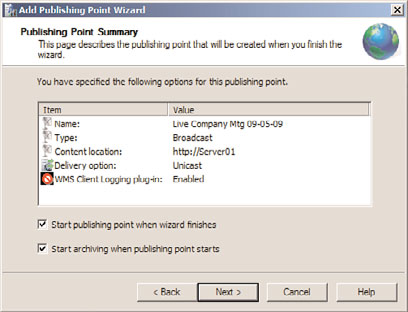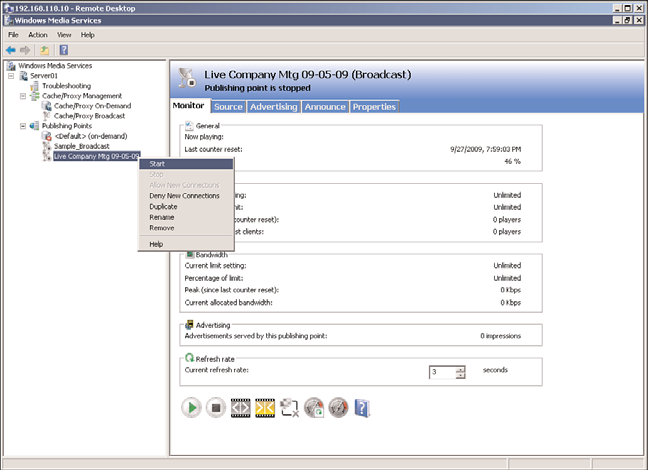Windows Server 2008 R2 Unleashed (294 page)
Read Windows Server 2008 R2 Unleashed Online
Authors: Noel Morimoto

of the broadcast over the Internet.
4. Select Encoder (A Live Stream) and click Next.
5. Select Broadcast Publishing Point and click Next.
6. Select Unicast or Multicast as the delivery option for the broadcasting publishing
point, and then click Next.
Unicast Versus Multicast
The Unicast delivery option sets up a one-to-one video stream between the Windows
Media server and each client system, whereas the Multicast delivery option sends a
single video stream that can be accessed by multiple users simultaneously.
ptg
The unicast delivery method is simpler to configure and more likely to work without
36
much network infrastructure (router, firewall, system configuration) changes. However,
unicast is a significantly more bandwidth-intensive environment. Because each client-to-
server session is a separate video stream, a broadcast with 10 users would have 10
video streams from the server to the clients, and a broadcast with 100 users would
feature 100 video streams from the server to the clients. For a relatively small or low-
demand Windows Media server environment, unicast delivery is easier to implement,
but be careful when using unicast delivery in large or broadly distributed environments.
The multicast delivery method sends a single video stream out on the network, which
can be accessed by multiple client systems simultaneously. With a multicast delivery
stream, whether 10 users or 100 users need to access the system, there is only a
single broadcast either way. However, for a multicast delivery to work, the routers must
be configured to support multicast routing. The client systems receiving the multicast
broadcasts need to be running Windows 2000 Professional, Windows XP Professional,
Windows Vista, Windows 7, Windows 2000 Server, Windows Server 2003, Windows
Server 2008, or Windows Server 2008 R2.
An additional consideration for choosing between the unicast and multicast delivery
methods is the number of clients that expect to connect to the broadcast stream and
the variation of client configurations. If the compatibility to accept broadcasts from vari-
ous systems is important and the number of connections to a broadcast stream is lim-
ited, the unicast method will provide better compatibility. If the organization controls the
desktop configurations and knows the client systems can accept multicast broadcasts
and the organization is broadcasting a video to be received by many users, the multi-
cast delivery method will lessen the demand on network bandwidth.

1494
CHAPTER 36
Windows Media Services
7. Enter the uniform resource locator (URL) for the encoder. This is typically the name
of the Windows Media server, such as http://server1 or
http://media.companyabc.com, depending on whether the server has been added to
DNS for naming. Click Next to continue.
8. Select the Enable Logging option if you want to log media events, and then click Next.
9. The next screen shows a summary of the created publishing point, similar to the one
shown in Figure 36.3. You can choose to start the publishing point when the wizard
is finished, and if you want to capture and archive the live event, select the Start
Archiving When Publishing Point Starts option. Click Next.
ptg
FIGURE 36.3
Creating a publishing point.
10. Before finishing with the Add Publishing Point Wizard, you are prompted to choose
between three file creation options:
.
Create an Announcement File (.asx) or Web Page (.htm)—
An announce-
ment file is similar to an invitation file that can be used to notify users of a
pending live broadcast or the availability of an on-demand video playback
session.
.
Create a Wrapper Playlist (.wsx)—
A wrapper playlist is content that can be
added to either the start or end of a broadcast. An example of wrapper content
might be a welcome or closing message, advertisements, or broadcast identifi-
cation.
.
Create a Wrapper Playlist (.wsx) and Announcement File (.asx) or Web
Page (.htm)—
Choosing this option launches both the Announcement File
and Wrapper Playlist Wizards to create the invitation announcement, as well as
the capability to add content at the start or end of a broadcast.
Choose one of these three options or deselect the After the Wizard Finishes check
box if you don’t want to choose any of the options. Click Finish when complete.

Broadcasting Stored Single Files
1495
Starting a Real-Time Live Broadcast
A live broadcast can be started immediately or at a later time. Many organizations create
the live broadcast publishing point and test the session to ensure that the session process
is working properly. Some key aspects to test include making sure the camera and lighting
are acceptable for view, ensuring that the microphone is working, and ensuring the audio
quality and volume are acceptable.
After the live broadcast is tested, the session can be stopped and started at the time of the
live broadcast. To start a broadcast, right-click on the publishing point, and select Start, as
shown in Figure 36.4.
ptg
36
FIGURE 36.4
Starting a publishing point.
When the broadcast is complete, clicking the Stop button stops the broadcast session.
Broadcasting Stored Single Files
A Windows Media Services system can be set up to host the broadcasting of a single video
file. A single video file broadcast is typically set up on demand, meaning that a user
requests the playback of the video file on request. On-demand video playbacks are
commonly used for replays of video files, such as on-demand training classes, or viewing
captured meetings or presentations.
1496
CHAPTER 36
Windows Media Services
Configuring a Server for Single On-Demand Video Playback
To configure a Windows Media server for on-demand video playback broadcasts, a
publishing point needs to be configured for on-demand communications. The configura-
tion process is as follows:
1. In the Windows Media Services MMC, right-click on Publishing Points in the naviga-
tion tree, and select Add Publishing Point (Wizard).
2. Click Next to move past the Welcome screen.
3. Enter a publishing point name that describes the function. In the case of this on-
demand single file broadcast, you might choose something like Company Mtg 11-16-
2009. Click Next to continue.
NOTE
The name of a publishing point should not have special characters, such as <, >, \, ?,
%, &, ‘, #, “, {, }, [, ], or *. These characters can interfere with the successful publishing
of the broadcast over the Internet.
4. Select One File (Useful for a Broadcast of an Archived File), and click Next.
ptg
5. Choose either Broadcast Publishing Point or On-Demand Publishing Point, and
click Next.
Broadcast Publishing Versus On-Demand Publishing
Broadcast publishing is a process where the publishing of a video is scheduled, similar
to a television program. A time is scheduled when the stored video file will be played
back. This might be used in an environment in which training videos are played back
during specific times during the day for employees to view.
On-demand publishing is a process where an individual requests the playback of a
video file. This allows users the flexibility of deciding when they watch a video.
As each session is independent with on-demand video, there is no benefit to doing a
multicast session because the video will only be viewed by an individual. Therefore, the
default delivery option for on-demand published videos is unicast, and the multicast
option is not provided.
When choosing a broadcast published video, because multiple users are likely to
access the broadcast at the same time, the organization can choose to multicast the
video as long as the remote client systems and network infrastructure support multi-
cast video routing. With multicast delivery, the Enable Unicast Rollover option provides
a unicast delivery stream if the remote client does not support multicast broadcasts.
At this point, whether you selected Broadcast Publishing Point or On-Demand
Publishing Point in step 5 will determine what options are available in the remaining
steps of the wizard.
Broadcasting Stored Single Files
1497
If you selected On-Demand Publishing Point in step 5, you will be prompted to either
add a new publishing point (which will start the wizard over at step 2), or you can select
Use an Existing Publishing Point and then click Next to finish the on-demand file
publishing point.
If you selected Broadcast Publishing Point in step 5, you will be prompted with several
other options:
1. Select Unicast or Multicast as the delivery option for the broadcasting publishing
point, and then click Next.
2. You will then be prompted for the name of the file that you want to publish. Select
the file and then click Next.
3. Select the Enable Logging option if you want to log media events, and then click Next.
4. The next screen shows a summary of the created publishing point. You can choose
to start the publishing point when the wizard is finished, and if you want to capture
and archive the live event, select the Start Archiving When Publishing Point Starts
option. Click Next to continue.
5. Before finishing the Add Publishing Point Wizard, you are prompted to choose
between three file creation options:
ptg
.
Create an Announcement File (.asx) or Web Page (.htm)—
An announce-
ment file is similar to an invitation file that can be used to notify users of a
36
pending live broadcast or the availability of an on-demand video playback
session.
.
Create a Wrapper Playlist (.wsx)—
A wrapper playlist is content that can be
added to either the start or end of a broadcast. An example of wrapper content
might be a welcome or closing message, advertisements, or broadcast identifi-
cation.
.
Create a Wrapper Playlist (.wsx) and Announcement File (.asx) or Web
Page (.htm)—
Choosing this option launches both the Announcement File
and Wrapper Playlist Wizards to create the invitation announcement, as well as
the capability to add content at the start or end of a broadcast.
Choose one of these three options or deselect the After the Wizard Finishes check
box if you don’t want to choose any of the options. Click Finish when complete.
Starting a Single File Publishing Point
A single file publishing point can be started immediately or at a later time. Unless the
broadcast is to be scheduled at a different time, usually single file publishing points are
started immediately so that they can be accessed at any time. Testing a file publishing
point ensures that the session process is working properly. Some key aspects to test
include making sure the multicast delivery broadcasting is working properly, and that the
video and audio quality and volume are acceptable.
1498
CHAPTER 36
Windows Media Services
Hosting a Directory of Videos for On-Demand Playback
If the organization wants to publish an entire directory of files, the Windows Media server
can be configured to publish a number of video files. The hosting of a directory of videos
